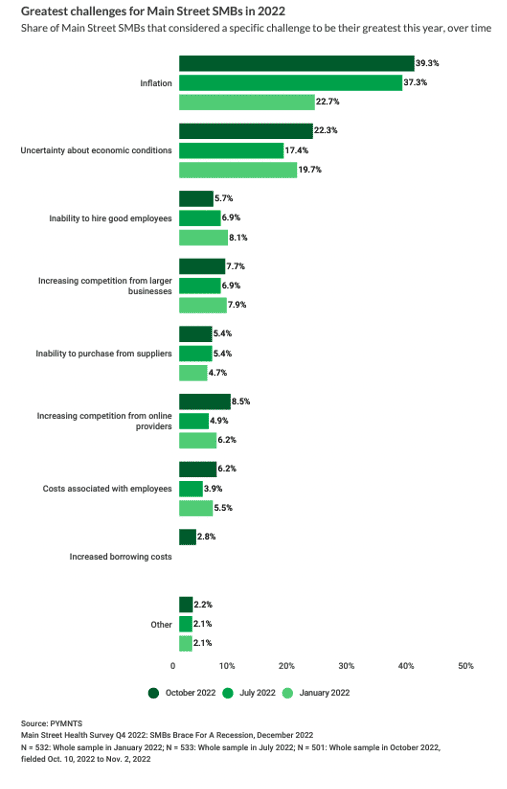Small Businesses Divided on How to Handle Recession

Main Street small businesses have been preparing for this inflationary cycle to turn to recession.
Yet, additional pressure from labor costs and online competition have prevented them from implementing price markups or cost cuts. Suddenly, the “R-word” is dominating business headlines. Recession talk has replaced assurances that the economy will soon begin to stabilize.
But recession news is not new to PYMNTS, or the small- to medium-sized businesses (SMBs) covered in studies such as the latest Main Street Health survey. However, the most recent predictions of a further downturn bring a new sense of urgency. Sixty-four percent of Main Street SMBs said they expect the U.S. economy to enter a recession, with 38% convinced it is already here. A further 26% said they believe a recession will arrive in the first half of 2023. Less than a quarter of SMBs said they think inflation will return to pre-2021 levels within a year.
Inflation, along with its associated increased costs, tops the list of Main Street SMBs’ concerns.

Over half of Main Street SMBs have already been operating on slim margins. In October, 58% of surveyed SMBs reported decreased profit margins from the same time last year. Perhaps unsurprisingly, this rate was higher for smaller firms. Sixty-eight percent of firms with less than $150,000 in annual revenues reported decreased profit margins in the last 12 months.
Marking up prices is the primary method Main Street SMBs have been using to fend off inflation, with 31% of businesses citing this as the most important strategy. The other, more time-consuming approach — but perhaps more effective in the long term — is cost-cutting.
To be sure, this isn’t nearly as popular as price markups. Only 11% of SMBs reported implementing this as their top strategy in October (16% did so in July). Another 13% said they were working on improving productivity in October, unchanged from July.
It’s tempting to rely solely on price markups to increase profit margins. However, with over 60% of consumers living paycheck to paycheck, there are limits to what customers may be willing to pay. And, if the economic struggles continue as predicted, manufacturing costs could easily disrupt those margins.
Implementing a more robust cost-cutting approach may be a more effective long-term solution, and there are multiple avenues to accomplish this goal. Back-office automation, payments orchestration and greater digital payment adoption are all tools Main Street SMBs can use to increase margins. Perhaps most importantly, these strategies enable SMBs to keep prices lower for longer — and keep customers coming back.
